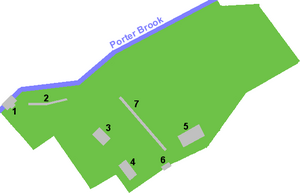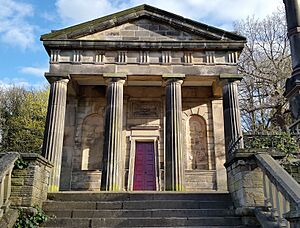Sheffield General Cemetery facts for kids
The General Cemetery in Sheffield, England, is a special historical park. It first opened in 1836 and was used for burials until 1978. This cemetery was the main place for burials in Victorian Sheffield, with over 87,000 people buried there.
Today, it's recognized as a very important historical landscape. It's listed on the English Heritage National Register of Historic Parks and Gardens (Grade II*). It's also a Local Nature Reserve, which means it's a protected area for local wildlife. The City of Sheffield owns the cemetery, and a local group, the Sheffield General Cemetery Trust, helps manage it.
Contents
Where is the General Cemetery?
The General Cemetery is located a little over a mile southwest of Sheffield city centre. You can find it in an area called Sharrow. It sits on a hillside that faces north, between Sharrow Vale and Sharrow Head. A small river, the Porter Brook, flows along one side. Cemetery Road forms the boundary on the other side. You can enter through the Gatehouse, which is off Ecclesall Road on Cemetery Avenue.
A Look Back: History of the Cemetery
The General Cemetery was one of the first cemeteries in Britain that was designed like a park and run as a business. It opened in 1836 because Sheffield was growing very fast. The old churchyards in town were becoming too full and messy.
The cemetery was first designed for Nonconformists, who were Protestants not part of the Church of England. It featured buildings in old Greek and Egyptian styles. Samuel Worth, a Sheffield architect, designed it on what used to be a quarry. Robert Marnock, who also designed the Sheffield Botanical Gardens, helped with the landscape.
The very first person buried here was Mary Ann Fish, who died from tuberculosis. Later, in 1846, a section for Anglican burials was added. This part had its own chapel designed by William Flockton. A wall was built to separate the two sections, and you can still see it today.
By 1916, the cemetery was getting full. While some family plots were still used in the 1950s and 60s, the cemetery officially closed for new burials in 1978. Sheffield City Council took over the cemetery. In 1980, they got permission to clear about 800 gravestones to create a recreation area. For many years, much of the cemetery was left to grow wild, becoming a home for local wildlife. Sadly, some of the old buildings also started to fall apart.
In 2003, work began to restore the Gatehouse and the Catacombs. This was made possible by a large grant. Today, the restored Gatehouse is home to the Sheffield General Cemetery Trust's offices.
Important Buildings and Structures
The General Cemetery has several unique and historic buildings.
- The Gatehouse (a really important historical building, Grade II* listed) is built right over the Porter Brook river. It has a mix of old Greek and Egyptian styles. The entrance looks like an old Roman arch. Some people think building it over the river was a symbol, like crossing the river Styx in Greek mythology to enter the afterlife.
- The Egyptian Gate (also Grade II* listed) is the upper entrance to the cemetery on Cemetery Road. It has many decorations, including gates with ouroboros symbols. These are two snakes coiled in a circle, biting their own tails.
- The Nonconformist Chapel (Grade II* listed) also combines old Greek and Egyptian styles. Above its door, there's a sculpted picture of a dove, which represents the Holy Spirit. Stone steps lead down to a wall with entrances that look like catacombs.
- The Anglican Chapel (added in 1850; Grade II listed) was designed by William Flockton in the Neo-Gothic style. This is different from the other buildings, which are more Greek or Egyptian. It has pointed windows and a very tall spire. The spire was made extra-large so it could be seen from far away.
- The Registrar's House (Grade II listed)
- The Catacombs are two rows of underground burial chambers built into the hillside. This way of burial was not very popular. Only ten bodies were placed in the catacombs during the first ten years.
- The Dissenters' Wall was built between 1848 and 1850. It separated the older Nonconformist part of the cemetery from the Anglican section. The wall runs almost all the way from Cemetery Road down to the path by the Porter Brook.
Famous People Buried Here
Many interesting people are buried at the General Cemetery. Here are a few:
- George Bassett (1818–1886): He started The Bassett Company, which invented Liquorice Allsorts sweets! He was also the Mayor of Sheffield in 1876.
- George Bennett (1774–1841): He started the Sheffield Sunday School movement. His memorial is a Grade II listed monument.
- John, Thomas, and Skelton Cole: They founded Sheffield's Cole Brothers department store in 1847, which is now part of John Lewis Partnership.
- Francis Dickinson (1830–1898): He was a soldier who fought in the famous Charge of the Light Brigade during the Crimean War.
- William Dronfield (1824–1891): He founded the United Kingdom Alliance of Organised Trades, which helped inspire the creation of the Trades Union Congress.
- Mark Firth (1819–1880): A very important steel manufacturer and Mayor of Sheffield in 1874. He also founded Firth College in 1870, which later became the University of Sheffield. His monument is Grade II listed.
- William Flockton: The architect who designed the Anglican chapel.
- John Gunson (1809–1886): He was the chief engineer for the Sheffield Water Company when the Dale Dyke Dam collapsed in 1864. This caused the Great Sheffield Flood. Samuel Harrison, who wrote about the flood, and 77 flood victims are also buried here.
- Samuel Holberry (1816–1842): A key leader in the Chartist movement, which fought for workers' rights.
- Mary Holberry (1816–1883): Samuel Holberry's wife and also a Chartist.
- Isaac Ironside (1808–1870): Another Chartist and local politician.
- James Montgomery (1771–1854): A famous poet and publisher. His grave and monument were moved to Sheffield Cathedral in 1971.
- James Nicholson (died 1909): A well-known industrialist from Sheffield. His family memorial is Grade II listed.
- William Parker: A merchant. His monument, built in 1837, is Grade II listed.
- William Prest (died 1885): A cricketer and footballer who helped start the Sheffield Football Club.
- Maria Gomersal (1844–1871): An operatic singer and actress.
- Eliza Rooke (1824–1856): A political activist.
- Dr Attracta Rewcastle (1901–1951): A Surgeon Lieutenant-Commander.
- Alice Hall (1866–1935): A children’s author and a campaigner for women’s rights.
- Leopold Lichtenthal (1832–1849): A young Russian who died after falling from a horse.
- Samuel Morgan Smith (1833–1882): A famous Black tragedian (actor).
- Robert Fossett (1826–1875): The owner of Fossett’s Circus.
- Harvey Teasdale (1817–1904): A well-known Sheffield entertainer.
- Sergeant Thomas Sands (1783–1850): A sergeant in the King’s Dragoon Guards who fought in the Battle of Waterloo.
- George Myers, Francis Dickinson, Charles Partington: Veterans of the Crimean War.







